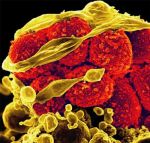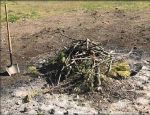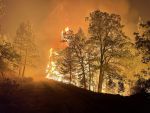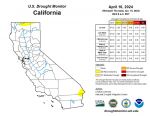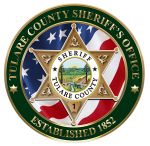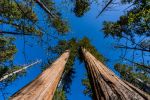
(Left) Although there is some removal of dead and dying trees taking place along roads, trails and recreation sites, many more dead trees remain in California forests. Forestry leaders say dead trees, such as seen along Highway 120 near Groveland, above, represent a public safety hazard and could fall down during winter storms.
Photo/Shaun Croo
A U.S. Forest Service survey, released in June, revealed that 66 million trees—mostly pine species—have died in the southern Sierra alone, due to bark beetle infestations, drought, wildfire and climate change. One question now, experts say, is what will replace those dead trees.
"We know in the Sierra and Sequoia national forests east of Fresno, the beetles have killed at least 85 percent of the entire pine vegetative type and at least 20 percent of the mixed conifer type, which is pine and fir," said Steve Brink, California Forestry Association vice president of public resources. "By the end of this summer, essentially 100 percent of the pine type will be dead in the Sierra and Sequoia national forests, and you are going to have a massive conversion to chaparral."
In the last 15 years, national forests in California are burning at an average rate of 320,000 acres a year and, Brink said, "the intensity of those fires has been increasing steadily."
Causing the explosive fires, he said, are overly dense forested areas that grow at the rate of 4 billion board-feet a year. Forest thinning and prescribed burning removes less than 10 percent of the annual growth. Brink said USFS inventories show 300 trees per acre on a landscape that only has enough water to sustain 20 to 100 trees an acre.
"There has to be at least consideration of a massive effort to aggressively remove much of the dead, beetle-killed trees and replant to the species that want to be there, whether it is pine or fir," he said.
Bill Stewart, co-director of the Center for Forestry at the University of California, Berkeley, said bark beetles "are wreaking havoc on the large-diameter pine trees, leaving the forest with small-diameter and younger pine trees, incense cedar, fir trees and hardwoods like black oak and laurel trees."
Challenges, Stewart said, include whether the Forest Service will have the funds and skill to replant these forests before the shrubs go wild and take over.
Marc Meyer, an ecologist with the USFS Pacific Southwest Region, said research indicates stands of pine trees at lower elevations will be exposed to a change in climate and, inevitably, "conifers will disappear." In some cases, these trees will move upslope in the Sierra Nevada or to areas that have a cooler microclimate, he said.
"As you go from a tree-dominated to a shrub-dominated system, you start to lose some of those ecosystem services, but even chaparral has a lot of benefits. But you have a new fire regime and they (shrubs) are a little more susceptible to perpetuating more of a frequent fire system," Meyer said. "A lot of those stands where you have 95 to 99 percent of mortality of conifers, you see that the oak species are doing quite well."
Meyer cited mechanical thinning and prescribed burning as treatments used by the Forest Service to improve forest conditions, adding, "Some of these landscapes can be thinned or restored using fire alone."
The more forest restoration work the Forest Service and others do to buffer stands of trees from the impact of climate change, drought and beetles, Meyer said, "the better off we are going to be in the future."
Shaun Crook, a timber operator and president of the Tuolumne County Farm Bureau, said drought and beetle infestations are cyclical, but that "40 years of mismanagement" have left forests vulnerable.
"The forests haven't been grazed, they haven't been logged and you add four years of drought and another cycle of the bark beetle and you've got the perfect storm. Now, we're going to pretty much eliminate pine forests under 4,000 feet in most areas of the Sierra," Crook said.
In the foothills near Groveland, he said, he can look in all directions and count dead trees remaining from the 2013 Rim Fire or as a result of beetle infestations.
"I'm on a road overlooking a canyon and it would take a few weeks to count as many dead trees as I can see here," Crook said. "Until you actually see it, it is hard to fathom.
"What brings all of this full circle, especially in California," he said, "is all of our waters start in the forest, and forest health means more water running down the rivers and into reservoirs that can eventually be used for growing food and other uses. If we allow this conversion to chaparral, you are not going to have the snowpack accumulation on the ground."
Gov. Brown declared a state of emergency last fall because of tree die-off and formed a Tree Mortality Task Force to assist with safe removal of dead and dying trees. Some government funding has been directed to California for removal of dead trees along roads, trails and recreation sites where falling timber is likely to threaten people, powerlines and structures, but forestry experts believe the threat to public safety remains.
"All it is going to take is one good windstorm. All of this material is going to get blown over," Crook said. "We have homes and communities in the midst of all of these forests."
Brink predicted that in about a year, the Forest Service will close forests to the public due to safety concerns.
Erin Huston, federal policy consultant for the California Farm Bureau Federation, said Farm Bureau has been actively engaged in addressing the state's tree mortality challenges, as well as reducing fire hazards in California forests. As part of a drought-preparedness effort by the Obama administration, Huston attended a meeting in Washington, D.C., that discussed forest management.
"The administration is addressing forest management under their Climate Action Plan, but it is for drought and they are looking at the relationships between forests and water as part of that strategy," Huston said. "There are a lot of diverse interests taking notice of the tree mortality issue because of what they get from the forests, whether it be water or forestry."
She said CFBF also supports legislation to develop a wildfire emergency funding process that provides more reliable funding without harming land management and fire-reduction activities.
(Christine Souza is an assistant editor of Ag Alert. She may be contacted at csouza@cfbf.com.)
Reprinted with permission: California Farm Bureau Federation











